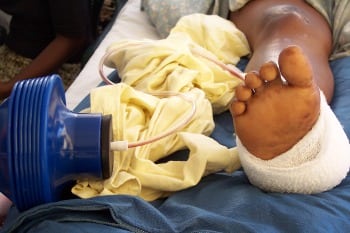
The Wound Pump in a field test in Haiti after the 2010 earthquake. Photo courtesy of Danielle Zurovcik
This innovation is one of our Promising Prototypes of IEEE’s Global Humanitarian Technology Conference in Seattle Oct. 30 – Nov 1. For more in the series, please see below.
With little more than off-the-shelf bellows pump, a rubber stopper and some surgical tubing, a team from MIT made a stand-in for a $25,000 medical device. In hospitals, negative-pressure wound therapy machines apply constant suction to wounds such as cuts, diabetic ulcers, burns and traumatic injuries. The suction stimulates healing three times faster or more, with less scar tissue. As unwieldy, expensive and power-hungry as the machines are, however, they are not available in many developing world medical centers. Not to mention emergency medicine or military battlefields.
The Wound Pump, based on a hand-operated bellows pump, is a simplified alternative to the machine. Danielle Zurovcik and a team at MIT developed the device to conform to low costs, portability and operation without electricity. It needs only 10 seconds of hand pumping every two or three days to maintain negative pressure. It’s not a poor substitute for the more expensive machines, either. The MIT team’s tests show that it compares in performance.
The Wound Pump can be the first such device available in many developing world clinics, Zurovcik tells E4C. “It can help heal potentially life threatening wounds in low resource settings,” Zurovcik says.
It’s able to maintain pressure over several days because it’s mostly air tight. Conventional negative pressure machines leak air during suction, but they can compensate by drawing power to run their pumps. The Wound Pump, on the other hand, is incredibly power efficient.
Local build and repair is important to the Wound Pump’s developers. “Local manufacturing will provide economic benefits to the local communities and ensure equal access to this wound-healing technology for all patients, says Danielle Zurovcik, an MIT PhD candidate working on the device.
Now the device is in clinical trials. One of the goals is to continue to simplify its use to reduce the amount of training that practitioners will need to operate it.
More Promising Prototypes at GHTC:
Salinity sensors boost yields on shrimp farms
Poultry Pharm: How eggs become drug factories
